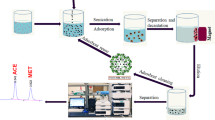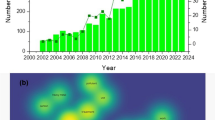Abstract
In this work, magnetic di-thio functionalized mesoporous silica nanoparticles (DT-MCM-41) were prepared by grafting dithiocarbamate groups within the channels of magnetic mesoporous silica nanocomposites. The functionalized nanoparticles exhibited proper magnetic behavior. They were easily separated from the aqueous solution by applying an external magnetic field. The results indicated that the functionalized nanoparticles had a potential for high-efficient removal of Hg2+ in environmental samples. The maximum adsorption capacity of the sorbent was 538.9 mg g−1, and it took about 10 min to achieve the equilibrium adsorption. The resulted adsorption capacity was higher than similar works for adsorption of mercury. It can be due to the presence of di-thio and amine active groups in the structure of sorbent. The special properties of MCM-41 like large surface area and high porosity also provided a facile accessibility of the mercury ions into the ligand sites. The complete removal of mercury ions was attained with dithiocarbamate groups in a wide range of mercury concentrations. The recovery studies were also applied for the river water, seawater, and wastewater samples, and the values were over of 97 %.









Similar content being viewed by others
References
Aguilar-Arteaga K, Rodriguez JA, Barrado E (2010) Magnetic solids in analytical chemistry: a review. Anal Chim Acta 674:157–165
Barakat MA (2011) New trends in removing heavy metals from industrial wastewater. Arab J Chem 4:361–377
Bibby A, Mercier L (2002) Mercury (II) ion adsorption behavior in thiol-functionalized mesoporous silica microspheres. Chem Mater 14:1591–1597
Brown J, Richer R, Mercier L (2000) One-step synthesis of high capacity mesoporous Hg2+ adsorbents by non-ionic surfactant assembly. Microporous Mesopororous Mater 37:41–48
Chojnacki A, Chojnacka K, Hoffmann J, Gorecki H (2004) The application of natural zeolites for mercury removal: from laboratory tests to industrial scale. Miner Eng 17:933–937
Dana E, Sayari A (2011) Effect of regeneration conditions on the cyclic performance of amine-modified SBA-15 for removal of copper from aqueous solutions: composite surface design methodology. Desalination 277:54–60
Deng S (2006) Sorbent technology. Encycl Chem Process. doi:10.1081/E-ECHP-120007963
Dong J, Xu Z, Wang F (2008) Engineering and characterization of mesoporous silica-coated magnetic particles for mercury removal from industrial effluents. Appl Surf Sci 254:3522–3530
Evangelista SHM, Deoliveira E, Castro GR, Zara LF, Prado AGS (2007) Hexagonal mesoporous silica modified with 2-mercaptothiazoline for removing mercury from water solution. Surf Sci 601:2194–2202
Feng X, Fryxell GE, Wang LQ, Kim AY, Liu J, Kemner KM (1997) Functionalized monolayers on ordered mesoporous supports. Science 5314:923–926
Fenglian F, Wang Q (2011) Removal of heavy metal ions from wastewaters: a review. J Environ Manage 92:407–418
Hakami O, Zhang Y, Banks CJ (2012) Thiol-functionalised mesoporous silica-coated magnetite nanoparticles for high efficiency removal and recovery of Hg from water. Water Res 46:3913–3922
Kanel S, Manning B, Charlet L, Choi H (2005) Removal of arsenic (III) from ground water by nanoscale zero-valent iron. Environ Sci Technol 39:1291–1298
Kim BC, Lee J, Um W, Kim J, Joo J, Lee JH, Kwak JH, Kim JH, Lee C, Lee H, Addleman RS, Hyeon T, Gu MB, Kim J (2011) Magnetic mesoporous materials for removal of environmental wastes. J Hazard Mater 192:1140–1147
Kurniawan TA, Chan G, Lo W, Babel S (2006) Comparisons of low-cost adsorbents for treating wastewaters laden with heavy metals. Sci Total Environ 366:409–426
Li G, Zhao Z, Liu J, Jiang G (2011) Effective heavy metal removal from aqueous systems by thiol functionalized magnetic mesoporous silica. J Hazard Mater 192:277–283
Lopes CB, Figueira P, Tavares DS, LinZ D-d-S AL, Duarte AC, RochaJ TT, Pereira E (2013) Core–shell magnetite-silica dithiocarbamate-derivatised particles achieve the water framework directive quality criteria for mercury in surface waters. Environ Sci Pollut Res 20:5963–5974
Mercier L, Pinnavaia TJ (1998) Heavy metal ion adsorbents formed by the grafting of a thiol functionality to mesoporous silica molecular sieves: factors affecting Hg (II) uptake. Environ Sci Technol 32:2749–2754
Parham H, Zargar B, Shiralipour R (2012) Fast and efficient removal of mercury from water samples using magnetic ironoxide nanoparticles modified with 2-mercaptobenzothiazole. J Hazard Mater 205:94–100
Savage N, Diallo M, Duncan J, Street A, Sustich R (2009) Nanotechnology applications for clean water, Elsevier, Amsterdam, The Netherlands
Selvam P, Bhatia S, Sonwane C (2001) Recent advances in processing and characterization of periodic mesoporous MCM-41 silicate molecular sieves. Ind Eng Chem Res 40:3237–3261
Senevirathna U, Zhang W, Gu H (2011) Effect of carboxylic and thiol ligands (oxalate, cysteine) on the kinetics of desorption of Hg (II) from kaolinite. Water Soil Pollut 215:573–584
Shahbazi A, Younesi H, Badiei A (2011) Functionalized SBA-15 mesoporous silica by melamine-based dendrimer amines for adsorptive characteristics of Pb (II), Cu (II) and Cd (II) heavy metal ions in batch and fixed bed column. Chem Eng J 168:505–518
Soleimani M, Mahmodi MS, Morsali A, Khani A, Ghahraman-Afshar M (2011) Using a new ligand for solid phase extraction of mercury. J Hazard Mater 189:371–376
Tchounwou PB, Ayensu WK, Ninashvili N, Sutton D (2003) Review: Environmental exposure to mercury and its toxic opathologic implications for public health. Environ Toxic 18:149–175
Yantasee W, Warner CL, Sangvanich T, Addleman RS, Carter TG, Wiacek RJ, Fryxell GE, Timchalk C, Warner MG (2007) Removal of heavy metals from aqueous systems with thiol functionalized superparamagnetic nanoparticles. Environ Sci Technol 41:5114–5119
Yu MQ, Tian W, Sun DW, Shen WB, Wang GP, Xu N (2001) Systematic studies on adsorption of 11 trace heavy metals on thiol cotton fiber. Anal Chim Acta 428:209–218
Acknowledgment
We gratefully acknowledge the financial support of this work by the Iranian National Science Foundation with grant number 92001925.
Author information
Authors and Affiliations
Corresponding author
Additional information
Responsible editor: Bingcai Pan
Rights and permissions
About this article
Cite this article
Mehdinia, A., Akbari, M., Baradaran Kayyal, T. et al. High-efficient mercury removal from environmental water samples using di-thio grafted on magnetic mesoporous silica nanoparticles. Environ Sci Pollut Res 22, 2155–2165 (2015). https://doi.org/10.1007/s11356-014-3430-6
Received:
Accepted:
Published:
Issue Date:
DOI: https://doi.org/10.1007/s11356-014-3430-6




